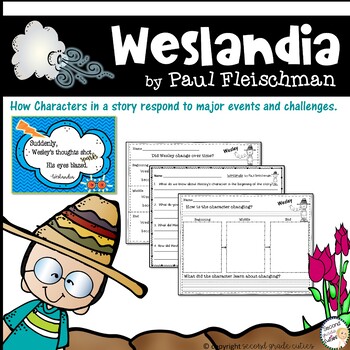Weslandia character changes, lessons learned
- PDF
- Easel Activity
What educators are saying
Also included in
- This book companion bundle uses stories that can teach young readers how to watch the character for theme changes. By using the signpost strategy (Notice and Note Strategies for Close Reading by K. Beers and N. Probst), students can gain a better understanding of key elements in fictional text.WhenPrice $12.00Original Price $15.00Save $3.00
Description
WESLANDIA by Paul Fleischman is a beautiful story which can teach young readers how to watch the character for theme changes. By using the signpost strategy (Notice and Note Strategies for Close Reading by K. Beers and N. Probst), students can gain a better understanding of key elements in fictional text.
When looking at the characters and major events, you can lead the class to see how these changes can affect the character over time. (This is the beginning of awareness for: character motivation, plot, conflict, foreshadowing ‘predictions’, and big life lessons or themes.)
In this story Wesley decides his summer project will be to create an new civilization. This story is sure to engage your students and offers lots of ideas for deep discussions regarding being true to yourself.
This resource can be transformed into a digital learning activity.
Questions that will lead your students to their very own ‘Ah- Ha’ moments are included.
What you’ll receive:
- Lesson and ‘leading’ questions to share during a read aloud
- Teacher & student questions
- Anchor Charts (to post & refer to during lesson)
- Sentence Frames
- Graphic Organizers to look at Character Traits
- Graphic Organizers to look at Major Events
- Graphic Organizers to look at:
- ‘How the Characters Change over time’ (for Wesley & his classmates)
- 'Swist' Flower/Word Art lesson…just for fun!
This book can also be found in the following bundle:
Read Aloud Series:
Boris and Bella ....Characters, lessons learned, & graphic organizers
Mr. Peabody's Apples...Characters, lessons learned, & graphic organizers
Other ELA Resources you might enjoy:
Comparing/Contrasting Themes, Settings, & Plots
(version for Grades 2 and Grades 3)
- - - - - - - - - - - - - - - - - - - - - - - - - - - - - - - - - - - - -
*FOLLOW ME HERE at Second Grade Cuties.
- - - - - - - - - - - - - - - - - - - - - - - - - - - - - - - - - - - - -
*And HERE on INSTAGRAM. Always fun to see resources in action!







